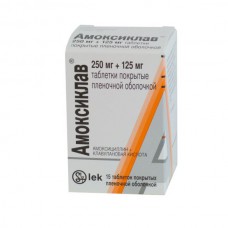Expiration date: 01/2026
Composition and form of issue:
Tablets, film-coated 1 tablet contains:
the active substance (core):
amoxicillin (trihydrate) 250 mg
clavulanic acid (in the form of potassium salt) 125 mg
auxiliary substances: silicon dioxide colloidal-5, 4 mg crospovidone-27, 4 mg croscarmellose sodium-27, 4 mg magnesium stearate-12 mg talc-13, 4 mg MKTS-up to 650 mg
film coating: gipromelloza-14, 378 mg ethyl cellulose 0, 702 mg Polysorbate 80-0, 78 mg triethyl citrate-0, 793 mg titanium dioxide-7, 605 mg talc 1, 742 mg
in bottles of dark glass 15, 20 or 21 tablets, 2 dehumidifiers in a pack of cardboard 1 bottle.
Tablets, film-coated 1 tablet contains:
the active substance (core):
amoxicillin (trihydrate) 500 mg
clavulanic acid (in the form of potassium salt) 125 mg
auxiliary substances: silicon dioxide colloidal-9 mg, crospovidone-45 mg, sodium croscarmellose-35 mg, magnesium stearate-20 mg, MCC - up to 1060 mg
film coating: hypromellose-17, 696 mg, ethyl cellulose-0, 864 mg, Polysorbate 80-0, 96 mg, triethyl citrate-0, 976 mg, titanium dioxide-9, 36 mg, talc-2, 144 mg
in bottles of dark glass 15 or 21 tablets, 2 desiccants in a pack of cardboard 1 bottle or blister 5 or 7 tablets in a pack of cardboard 2, 3 or 4 (5 tablets) or 2 (7 tablets) blister.
Tablets, film-coated 1 tablet contains:
the active substance (core):
amoxicillin (trihydrate) 875 mg
clavulanic acid (in the form of potassium salt) 125 mg
excipients: silicon dioxide colloidal-12 mg crospovidone-61 mg croscarmellose sodium-47 mg magnesium stearate-17, 22 mg MCC - 1435 mg
film coating: gipromelloza-23, 226 mg ethyl cellulose-1, 134 mg Polysorbate 80-1, 26 mg triethyl citrate-1, 28 mg titanium dioxide-12, 286 mg talc 2, 814 mg
in a blister pack of 5 or 7 tablets cardboard 2 or 4 (5 tablets) or 2 (7 tablets) blister.
Description of dosage form:
250 + 125 mg tablets: white or almost white, oblong, octagonal, biconvex, film-coated, with prints "250/125" on one side and "AMC" on the other side.
Tablets 500 + 125 mg: white or almost white, oval, biconvex, film-coated.
Tablets 875 + 125 mg: white or almost white, oblong, biconvex, film-coated, with a notch and prints "875" and "125" on one side and "AMC" on the other side.
View of the fracture: a mass of yellowish color.
Pharmacokinetics:
The main pharmacokinetic parameters amoxicillin and clavulanic acid are similar. Both components are well absorbed after ingestion, eating does not affect the degree of absorption. Peak plasma concentrations are reached approximately 1 h after ingestion. Cmax values are for amoxicillin (depending on the dose) 3-12 µg / ml, for clavulanic acid-about 2 µg / ml.
Both components are characterized by a good volume of distribution in the body fluid and tissues (lungs, middle ear, pleural and peritoneal fluid, uterus, ovaries, etc.). Amoxicillin also penetrates the synovial fluid, liver, prostate gland, Palatine tonsils, muscle, gall bladder, the secret of the sinuses, saliva and bronchial secret. Amoxicillin and clavulanic acid do not penetrate the BBB in unheated meninges.
Amoxicillin and clavulanic acid penetrate the placental barrier and are excreted in breast milk in trace concentrations.
Amoxicillin and clavulanic acid are characterized by low plasma protein binding.
Amoxicillin is partially metabolised, clavulanic acid is, apparently, an intense metabolism.
Amoxicillin is excreted by the kidneys almost unchanged by tubular secretion and glomerular filtration. Clavulanic acid is eliminated by glomerular filtration and partly in the form of metabolites. Small amounts can be excreted through the intestines and lungs. T1/2 amoxicillin and clavulanic acid is 1-1.5 hours in patients with severe renal insufficiency T1 / 2 increases to 7. 5 hours for amoxicillin and 4. 5 hours for clavulanic acid. Both components are removed by hemodialysis and minor amounts by peritoneal dialysis.
Description of the pharmacological action:
Amoxiclav is a combination of amoxicillin, a semi-synthetic penicillin with a broad spectrum of antibacterial activity and clavulanic acid, an irreversible inhibitor of &beta — lactamase.
Clavulanic acid forms a stable inactivated complex with &beta-lactamases and provides amoxicillin resistance to the effects of &beta-lactamases produced by microorganisms.
Clavulanic acid, similar in structure to & beta-lactam antibiotics, has weak antibacterial activity of its own. Amoxiclav has a wide range of antibacterial action. Active against sensitive strains to amoxicillin, including strains, producing &beta-lactamase:
- gram-positive aerobes: Streptococcus pneumoniae, Streptococcus pyogenes, Streptococcus viridans, Streptococcus bovis, Staphylococcus aureus (except metitillinrezistentnykh strains), Staphylococcus epidermidis (except metitillinrezistentnykh strains), Staphylococcus saprophyticus, Listeria spp., Enteroccocus spp.
- gram-negative aerobes: Bordetella pertussis, Brucella spp., Campylobacter jejuni, Escherichia coli, Gardnerella vaginalis, Haemophilus influenzae, Haemophilus ducreyi, Klebsiella spp., Moraxella catarrhalis, Neisseria gonorrhoeae, Neisseria meningitidis, Pasteurela multocida, Proteus spp., Salmonella spp., Shigella spp., Vibrio cholerae, Yersinia enterocolitica, Helicobacter pylori, Eikenella corrodens
- gram-positive anaerobes: Peptococcus spp., Peptostreptococcus spp., Clostridium spp., Actinomyces israelli, Fusobacterium spp., Prevotella spp.
- gram negative anaerobes: Bacteroides spp.
Indications:
Infections caused by sensitive strains of microorganisms:
- infections of the upper respiratory tract and ENT-organs (acute and chronic sinusitis, acute and chronic otitis media, occult abscess, tonsillitis, pharyngitis)
- infections of the lower respiratory tract (acute bronchitis with bacterial superinfection, chronic bronchitis, pneumonia)
- urinary tract infection
- infections in gynecology
- skin and soft tissue infections, including human and animal bites
- bone and connective tissue infections
- biliary tract infections (cholecystitis, cholangitis)
- odontogenic infections.
Contraindications:
- hypersensitivity to any of the components of the drug
- history of hypersensitivity to penicillins, cephalosporins and other & beta-lactam antibiotics
- history of indications for cholestatic jaundice and / or other disorders of liver function caused by taking amoxicillin/clavulanic acid
- infectious mononucleosis and lymphocytic leukemia.
With caution:
- pseudomembranous colitis in history
- liver failure
- severe impairment of renal function
- lactation.
Application for pregnancy and breastfeeding:
Amoxiclav may be administered during pregnancy when there are clear indications.
Amoxicillin and clavulanic acid in small quantities penetrate into breast milk.
Side effect:
Side effects in most cases are mild and transient.
From the digestive system: loss of appetite, nausea, vomiting, diarrhea rare abdominal pain, abnormal liver function, increased ALT or AST in a few cases — cholestatic jaundice, hepatitis, pseudomembranous colitis.
Allergic reactions: itching, urticaria, erythematous rashes rarely-multiform exudative erythema, angioedema, anaphylactic shock, allergic vasculitis in isolated cases — exfoliative dermatitis, Stevens-Johnson syndrome, acute generalized exanthematous pustules.
From the hematopoietic system and lymphatic system: rarely-reversible leukopenia (including neutropenia), thrombocytopenia very rare — hemolytic anemia, reversible increase in PV (when combined with anticoagulants), eosinophilia, pancytopenia.
From the nervous system: dizziness, headache is very rare-cramps (may occur in patients with impaired renal function when taking high doses of the drug), hyperactivity, anxiety, insomnia.
From the urinary system: very rarely-interstitial nephritis, crystalluria.
Other: rarely-candidiasis and other types of superinfection.
Drug interaction:
Antacids, glucosamine, laxatives, aminoglycosides slow down absorption, ascorbic acid increases absorption.
Diuretics, allopurinol, phenylbutazone, NSAIDs and other drugs that block tubular secretion, increase the concentration of amoxicillin (clavulanic acid is excreted mainly by glomerular filtration).
Simultaneous use of Amoxiclav and methotrexate increases the toxicity of methotrexate. Appointment conjunction with allopurinol increases the incidence of exanthema. Simultaneous use with disulfiram should be avoided.
In some cases, taking the drug can lengthen the PV, in this regard, caution should be exercised while prescribing anticoagulants and Amoxiclav.
The combination with rifampicin antagonistic (mutual weakening of the antibacterial effect). Amoxiclav should not be used simultaneously in combination with bacteriostatic antibiotics (macrolides, tetracyclines), sulfanilamides due to a possible decrease in the efficiency of Amoxiclav.
Probenecid reduces the excretion of amoxicillin, increasing its serum concentration. Antibiotics reduce the effectiveness of oral contraceptives.
Method of application and doses:
Inside.
Adults and children over 12 years of age (or &ge40 kg of body weight): the usual dose in case of mild to moderate infection is 1 table. 250 + 125 mg every 8 h or 1 table. 500 + 125 mg every 12 h, in the case of severe infection and respiratory infections — 1 table. 500 + 125 mg every 8 h or 1 table. 875 + 125 mg every 12 hours Tablets are not prescribed to children under 12 years (less than 40 kg of body weight).
The maximum daily dose of clavulanic acid (in the form of potassium salt) is for adults — 600 mg, for children — 10 mg/kg of body weight. The maximum daily dose of amoxicillin is for adults-6 g, for children — 45 mg / kg of body weight.
The course of treatment is 5-14 days. The duration of treatment is determined by the attending physician. Treatment should not last more than 14 days without re-medical examination.
Dosage for odontogenic infections: 1 table. 250 + 125 mg every 8 h or 1 table. 500 + 125 mg every 12 h for 5 days.
Dosage for renal failure: for patients with moderate renal insufficiency (Cl creatinine — 10-30 ml/min) dose is 1 table. 500 + 125 mg every 12 h for patients with severe renal insufficiency (Cl creatinine <10 ml/min) dose is 1 tab. 500 + 125 mg every 24 hours
In anuria, the interval between dosing should be increased to 48 hours or more.
Overdose:
There are no reported fatal or life-threatening side effects due to drug overdose.
Symptoms: in most cases — disorders of the gastrointestinal tract (abdominal pain, diarrhea, vomiting), it is also possible anxiety, insomnia, dizziness, in some cases — seizures.
Treatment: in case of overdose, the patient should be under medical supervision, treatment — symptomatic.
In the case of recent administration (less than 4 h) of the drug should be carried out gastric lavage and appoint activated charcoal to reduce absorption. Amoxicillin / clavulanate potassium is removed by hemodialysis.
Special instruction:
In the course of treatment, it is necessary to monitor the state of function of the hematopoietic organs, liver, kidneys.
In patients with severely impaired renal function requires adequate correction of the dose or interval between doses. In order to reduce the risk of side effects from the gastrointestinal tract should take the drug during meals.
Since the tablets combination of amoxicillin and clavulanic acid 250 + 125 mg and 500 + 125 mg contain the same amount of clavulanic acid — 125 mg, table 2. 250 + 125 mg is not equivalent to 1 table. 500 + 125 mg.
Laboratory tests: the high concentration of amoxicillin give a false positive reaction for glucose in urine when using Benedict's reagent or Fehling's solution. It is recommended to use enzymatic reactions with glucosidase.
Effects on ability to drive vehicles and operate machinery. Data on the negative impact of the drug Amoxiclav in recommended doses on the ability to drive or operate machinery no.




